|
Big siver strike around late 1890's..........boom lasted trough
about early 1920's.....various sporadic mining thereafter but
townsite is deserted and quite a few remains as it's hard to
reach destination has preserved it longer than normal. Submitted
by: Rick Perry
The gold rush was on in the Pahranagat Valley of Nevada when
farmers in 1890 and 1891 discovered gold in the hills around
the mountainous valley. In 1892, the Ferguson Mining District
was formed. Reports came into Pioche that assays of $75 to $1000
a ton of ore was being mined resulting in the first rush of miners
stampeding to the district.
While miners temporarily camped
in Golden City and the town of Helene, the town of Delamar soon
developed shortly thereafter when Capt. John DeLamar of Montana
purchased the principal claims in 1893 for $150,000 and established
the early settlement of the town.
The first post office was opened
in June 1894 and by the end of 1895, the camp had become a full-fledged
town containing many businesses and more than 300 dwellings.
By 1897, Delamar was home to more than 3,000 residents and supported
numerous stores, saloons, a theater and other establishments.
The extensive mining operation led to the town's reputation as
the "Maker of Widows" as the "Delamar Dust"
or silica dust inhaled by the miners led to many deaths. Two
years after 1900 when a fire destroyed half the town, Capt. DeLamar
sold his interest in the mines which had produced an estimated
$8.5 million in gold. The new owners, under the control of a
Simon
Bamberger, continued to outproduce all other mines in the state
until 1909 but the operation was closed soon after. The site
was reopened briefly from 1929-34 and evidence of a mining operation
continues there today. Nestled in the Delamar Mountain range
are partially standing rock buildings, mill ruins and a cemetery,
which some relatives apparently still visit.
Submitted by: Debra A. Estock
It was in the early 1890s when a wealthy Frenchman, Captain Joseph Rafael De La Mar began development of the rich mining camp in the Delamar hills. The town boomed from 1895 into the twentieth century, finally becoming a ghost town at the beginning of World War II, nearly a half century later. Delamar was known to many as the “widowmaker.” Several dozen women were widowed her. Because water was scarce, the crusher was run almost dry and created a fine dust that contained silica. The deadly dust was inhaled by the men, causing silicosis and an ultimately death. The dreaded dust also pierced lungs of women, children and animals. Water had to be hauled to all houses except one where it was tapped. In this house lived the “last rose of Delamar.” Agnes Horn, who had been there since childhood. Her husband was one of the young men felled by the dust. She was one of the camp's first settlers and among the last to leave. She was buried in the cemetery, beneath a rose bush that had once bloomed at her window. Submitted by Henry Chenoweth.
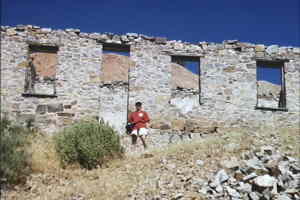
Delamar
Courtesy Debbie Estock
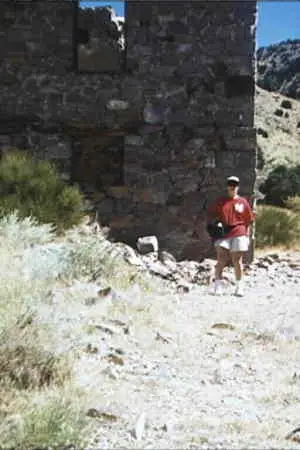
Delamar
Courtesy Debbie Estock

Delamar
Courtesy Debbie Estock

Delamar
Courtesy Debbie Estock
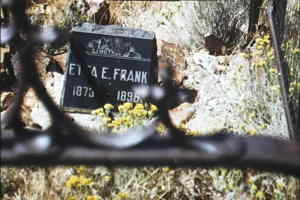
Delamar
Courtesy Debbie Estock
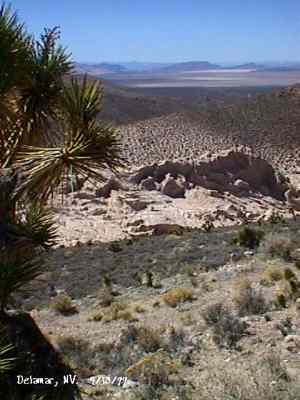
Delamar, Nevada. April 13, 1999.
Courtesy David A. Wright

Delamar, Nevada. April 13, 1999.
Courtesy David A. Wright
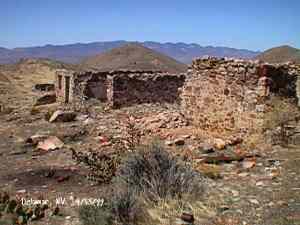
Delamar, Nevada. April 13, 1999.
Courtesy David A. Wright
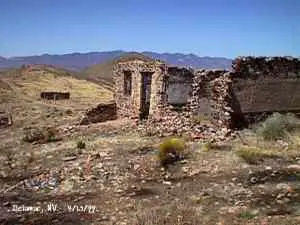
Delamar, Nevada. April 13, 1999.
Courtesy David A. Wright

Delamar, Nevada. April 13, 1999.
Courtesy David A. Wright

Delamar, Nevada. April 13, 1999.
Courtesy David A. Wright
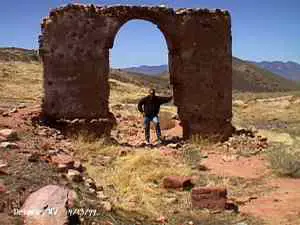
David A. Wright standing in archway of Delamar ruin. April 13,
1999. Alan H. Patera photo.
Courtesy David A. Wright
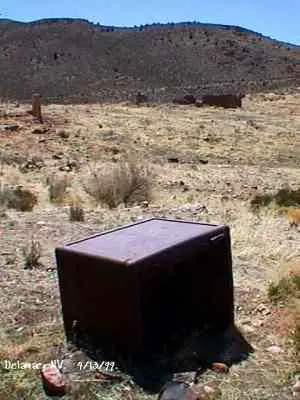
Delamar, Nevada. April 13, 1999.
Courtesy David A. Wright

Delamar, Nevada. April 13, 1999.
Courtesy David A. Wright

Delamar, Nevada. April 13, 1999.
Courtesy David A. Wright
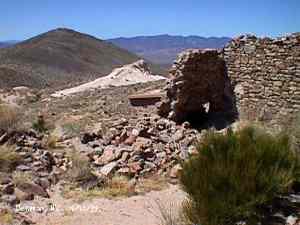
Delamar, Nevada. April 13, 1999.
Courtesy David A. Wright

Delamar
Courtesy Donna Lee Martin
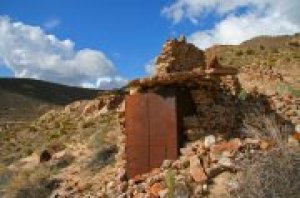
Delamar
Courtesy Donna Lee Martin

Delamar
Courtesy Donna Lee Martin
|
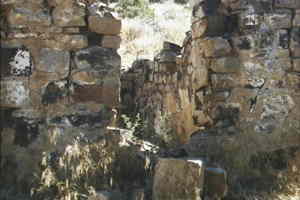
Delamar
Courtesy Debbie Estock
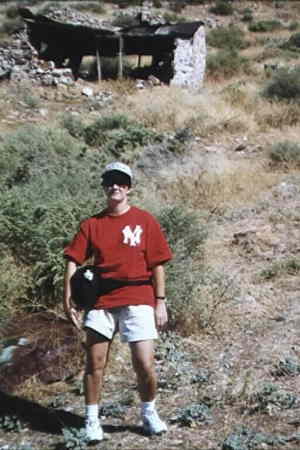
Delamar
Courtesy Debbie Estock
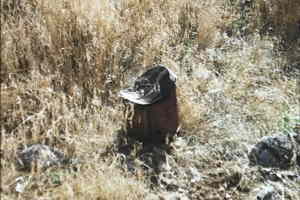
Delamar
Courtesy Debbie Estock

Delamar
Courtesy Debbie Estock
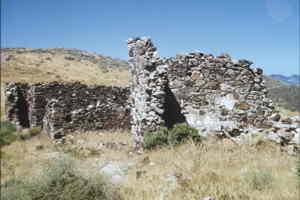
Delamar
Courtesy Debbie Estock

Delamar
Courtesy Debbie Estock

Delamar
Courtesy Debbie Estock

Delamar
Courtesy Debbie Estock
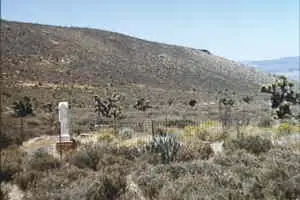
Delamar
Courtesy Debbie Estock

Delamar, Nevada. April 13, 1999.
Courtesy David A. Wright
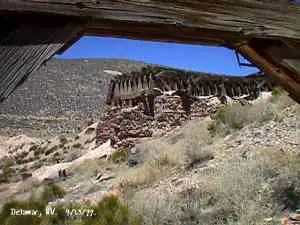
Delamar, Nevada. April 13, 1999.
Courtesy David A. Wright

Dust still flies off the huge tailings pile. This same dust once killed
many miners by silicosis, clogging up miner's lungs and caused their premature
deaths. On this gusty spring day in 1999, the dust could be felt in my
lungs (I have mild emphysema) and made my teeth gritty. April 13, 1999.
Courtesy David A. Wright

Delamar, Nevada. April 13, 1999.
Courtesy David A. Wright
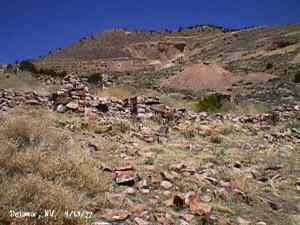
Delamar, Nevada. April 13, 1999.
Courtesy David A. Wright
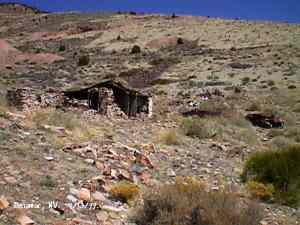
Delamar, Nevada. April 13, 1999.
Courtesy David A. Wright
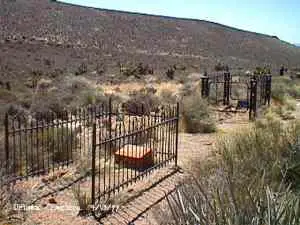
Delamar Cemetery. Unmarked grave. April 13, 1999.
Courtesy David A. Wright
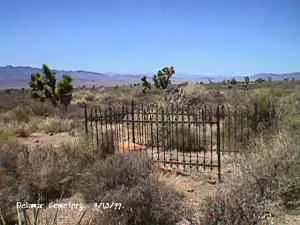
Delamar Cemetery. Grave of Robert Corkish, born October 12, 1871; died
November 21, 1915. Photo taken April 13, 1999.
Courtesy David A. Wright
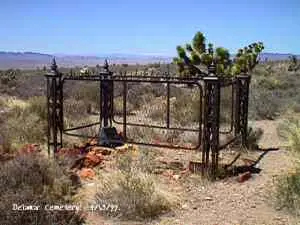
Delamar Cemetery. Grave of Etta E. Frank, 1873 to 1896. Photo taken
April 13, 1999.
Courtesy David A. Wright
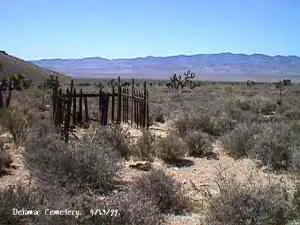
Delamar Cemetery. Unmarked grave. April 13, 1999.
Courtesy David A. Wright
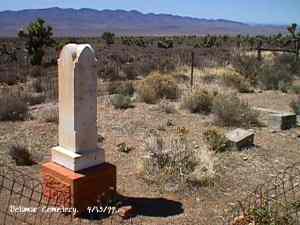
Delamar Cemetery. Grave of Fred A. Horn. Inscription on pillar reads:
"In Loving Memory of Fred A. Horn. Son of Agnes and ..." (marble pecked
away) ... "August 3, 1893 to March 25th, 1912. Dearest Fred, thou hast
left us here, thy lost we deeply feel, But tis God that hath bereft, he
can all our sorrows heal." Photo taken April 13, 1999. Courtesy David
A. Wright
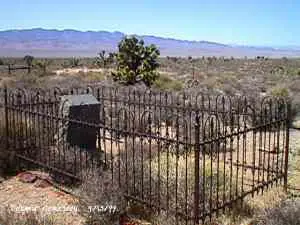
Delamar Cemetery. Grave of Richard Gordon. Born March 8, 1857. Died
November 2, 1907. Photo taken April 13, 1999.
Courtesy David A. Wright
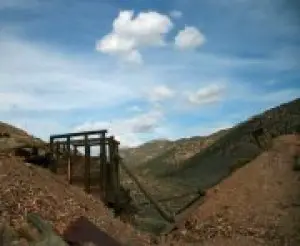
Delamar
Courtesy Donna Lee Martin

Delamar
Courtesy Donna Lee Martin
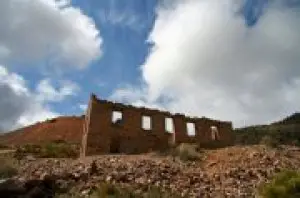
Delamar
Courtesy Donna Lee Martin
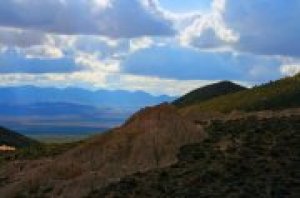
Delamar
Courtesy Donna Lee Martin
|